The Role of Outdoor Play in Holistic Child Development
VerifiedAdded on 2023/05/27
|8
|1991
|318
Essay
AI Summary
This essay discusses the importance of outdoor play in the development and growth of children, highlighting its role in physical exercise, cognitive learning, and social skill development. It emphasizes that outdoor play provides children with opportunities to explore, experiment, and learn about the world around them, which contributes to their overall well-being and future success. The essay also references the Surplus-energy theory, which suggests that outdoor play helps children release pent-up energy and recharge for academic learning. Different types of outdoor plays, such as physical play, constructive play, social play, and socio-dramatic play, are described as important for early childhood learning, each contributing uniquely to a child's cognitive, social, and physical development. Educators are encouraged to focus on these various types of play to ensure a well-rounded early childhood education.
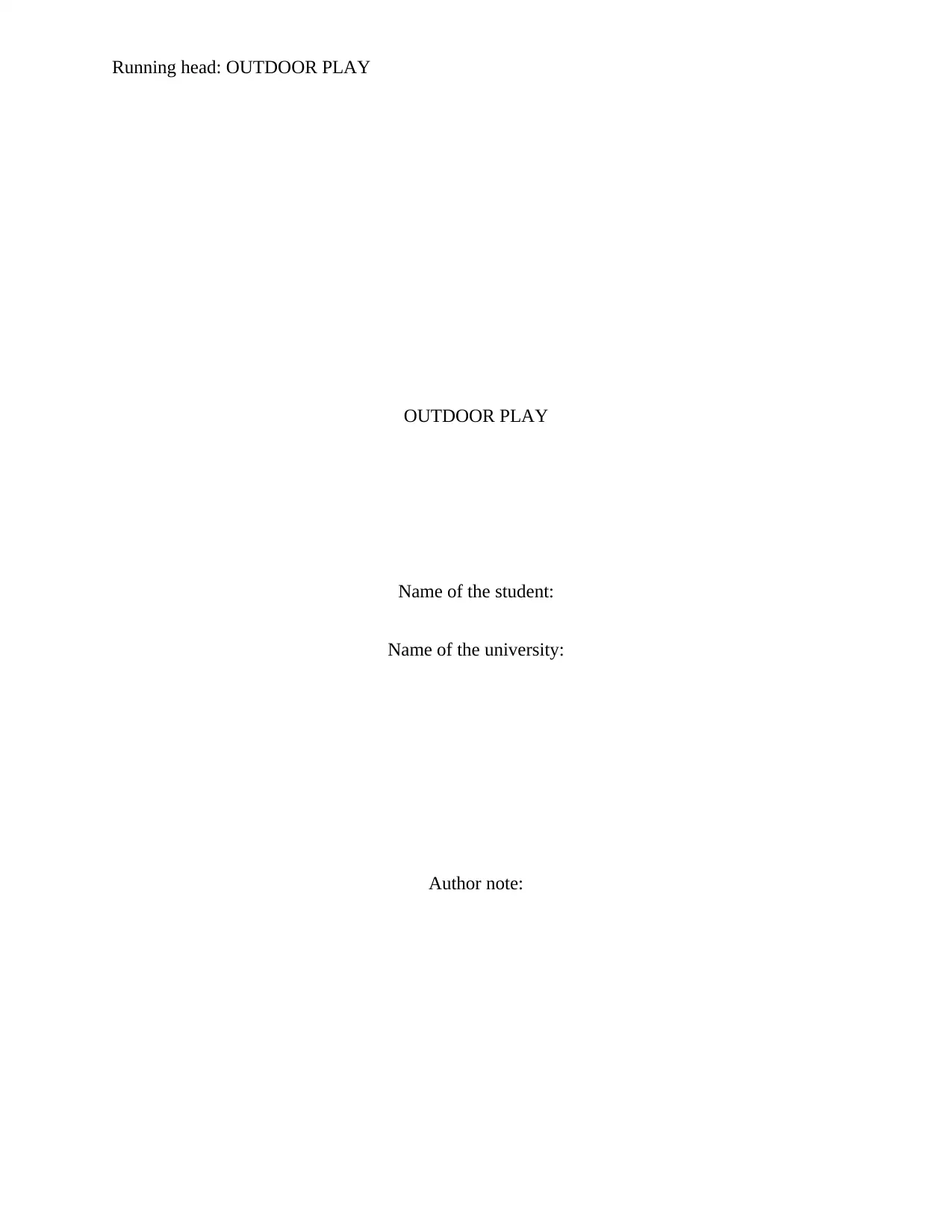
Running head: OUTDOOR PLAY
OUTDOOR PLAY
Name of the student:
Name of the university:
Author note:
OUTDOOR PLAY
Name of the student:
Name of the university:
Author note:
Paraphrase This Document
Need a fresh take? Get an instant paraphrase of this document with our AI Paraphraser
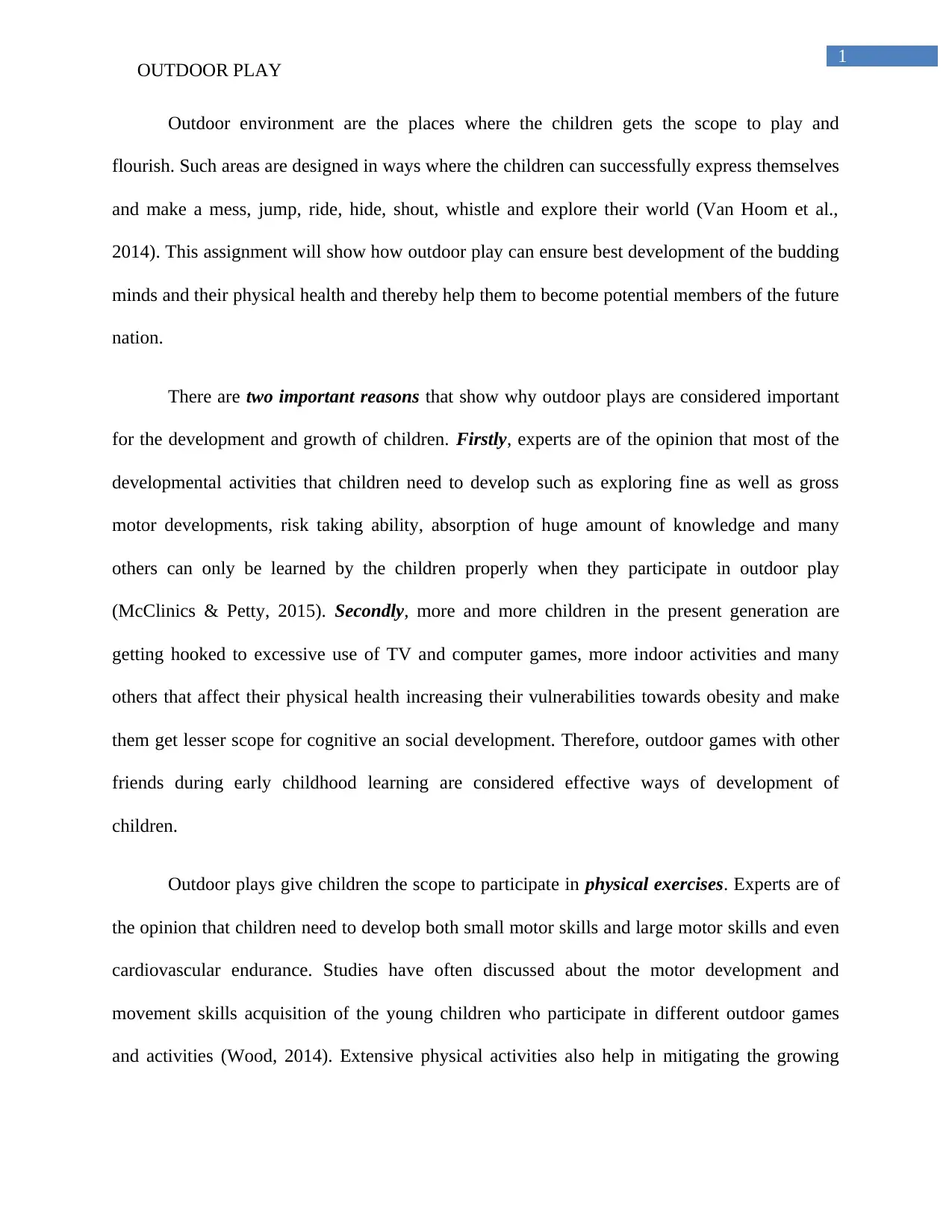
1
OUTDOOR PLAY
Outdoor environment are the places where the children gets the scope to play and
flourish. Such areas are designed in ways where the children can successfully express themselves
and make a mess, jump, ride, hide, shout, whistle and explore their world (Van Hoom et al.,
2014). This assignment will show how outdoor play can ensure best development of the budding
minds and their physical health and thereby help them to become potential members of the future
nation.
There are two important reasons that show why outdoor plays are considered important
for the development and growth of children. Firstly, experts are of the opinion that most of the
developmental activities that children need to develop such as exploring fine as well as gross
motor developments, risk taking ability, absorption of huge amount of knowledge and many
others can only be learned by the children properly when they participate in outdoor play
(McClinics & Petty, 2015). Secondly, more and more children in the present generation are
getting hooked to excessive use of TV and computer games, more indoor activities and many
others that affect their physical health increasing their vulnerabilities towards obesity and make
them get lesser scope for cognitive an social development. Therefore, outdoor games with other
friends during early childhood learning are considered effective ways of development of
children.
Outdoor plays give children the scope to participate in physical exercises. Experts are of
the opinion that children need to develop both small motor skills and large motor skills and even
cardiovascular endurance. Studies have often discussed about the motor development and
movement skills acquisition of the young children who participate in different outdoor games
and activities (Wood, 2014). Extensive physical activities also help in mitigating the growing
OUTDOOR PLAY
Outdoor environment are the places where the children gets the scope to play and
flourish. Such areas are designed in ways where the children can successfully express themselves
and make a mess, jump, ride, hide, shout, whistle and explore their world (Van Hoom et al.,
2014). This assignment will show how outdoor play can ensure best development of the budding
minds and their physical health and thereby help them to become potential members of the future
nation.
There are two important reasons that show why outdoor plays are considered important
for the development and growth of children. Firstly, experts are of the opinion that most of the
developmental activities that children need to develop such as exploring fine as well as gross
motor developments, risk taking ability, absorption of huge amount of knowledge and many
others can only be learned by the children properly when they participate in outdoor play
(McClinics & Petty, 2015). Secondly, more and more children in the present generation are
getting hooked to excessive use of TV and computer games, more indoor activities and many
others that affect their physical health increasing their vulnerabilities towards obesity and make
them get lesser scope for cognitive an social development. Therefore, outdoor games with other
friends during early childhood learning are considered effective ways of development of
children.
Outdoor plays give children the scope to participate in physical exercises. Experts are of
the opinion that children need to develop both small motor skills and large motor skills and even
cardiovascular endurance. Studies have often discussed about the motor development and
movement skills acquisition of the young children who participate in different outdoor games
and activities (Wood, 2014). Extensive physical activities also help in mitigating the growing
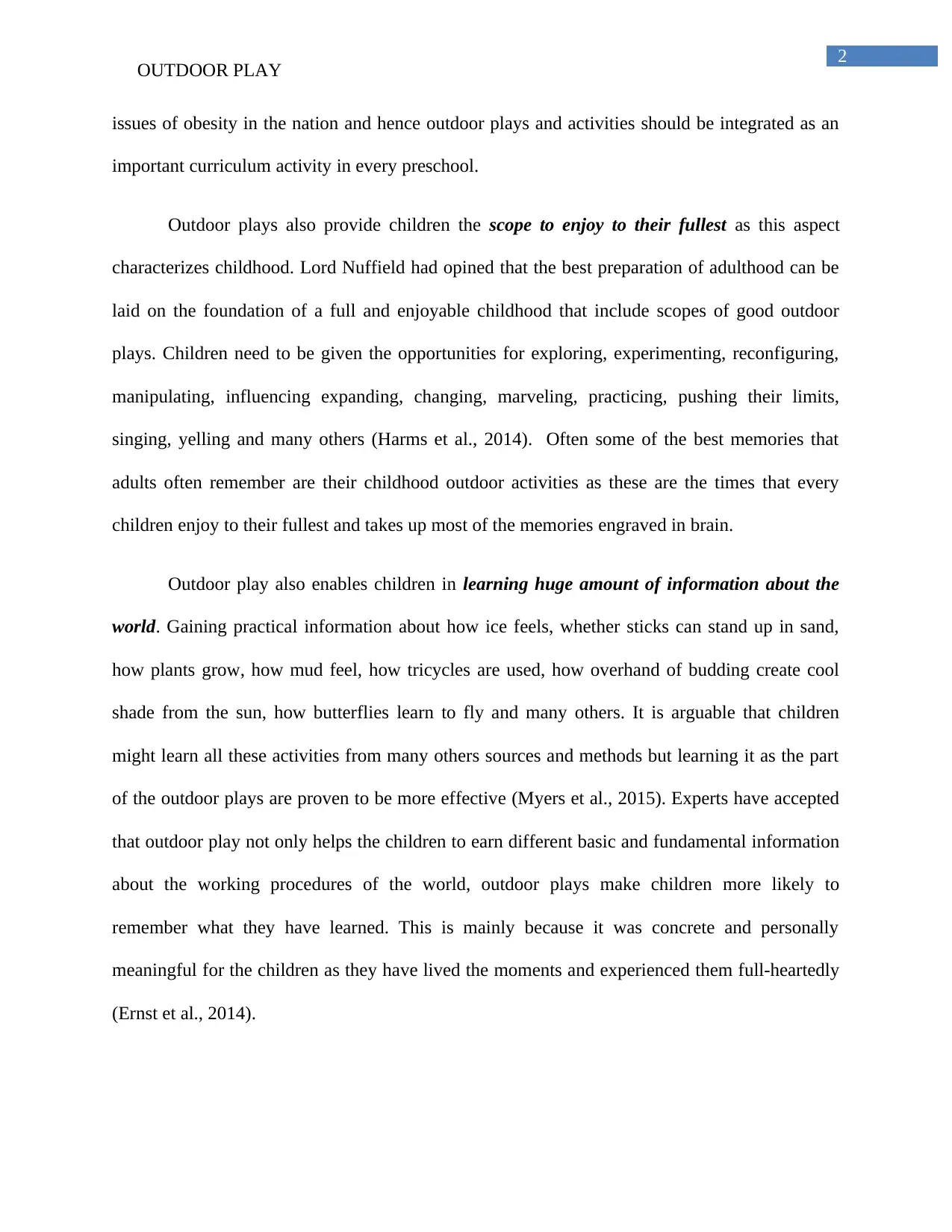
2
OUTDOOR PLAY
issues of obesity in the nation and hence outdoor plays and activities should be integrated as an
important curriculum activity in every preschool.
Outdoor plays also provide children the scope to enjoy to their fullest as this aspect
characterizes childhood. Lord Nuffield had opined that the best preparation of adulthood can be
laid on the foundation of a full and enjoyable childhood that include scopes of good outdoor
plays. Children need to be given the opportunities for exploring, experimenting, reconfiguring,
manipulating, influencing expanding, changing, marveling, practicing, pushing their limits,
singing, yelling and many others (Harms et al., 2014). Often some of the best memories that
adults often remember are their childhood outdoor activities as these are the times that every
children enjoy to their fullest and takes up most of the memories engraved in brain.
Outdoor play also enables children in learning huge amount of information about the
world. Gaining practical information about how ice feels, whether sticks can stand up in sand,
how plants grow, how mud feel, how tricycles are used, how overhand of budding create cool
shade from the sun, how butterflies learn to fly and many others. It is arguable that children
might learn all these activities from many others sources and methods but learning it as the part
of the outdoor plays are proven to be more effective (Myers et al., 2015). Experts have accepted
that outdoor play not only helps the children to earn different basic and fundamental information
about the working procedures of the world, outdoor plays make children more likely to
remember what they have learned. This is mainly because it was concrete and personally
meaningful for the children as they have lived the moments and experienced them full-heartedly
(Ernst et al., 2014).
OUTDOOR PLAY
issues of obesity in the nation and hence outdoor plays and activities should be integrated as an
important curriculum activity in every preschool.
Outdoor plays also provide children the scope to enjoy to their fullest as this aspect
characterizes childhood. Lord Nuffield had opined that the best preparation of adulthood can be
laid on the foundation of a full and enjoyable childhood that include scopes of good outdoor
plays. Children need to be given the opportunities for exploring, experimenting, reconfiguring,
manipulating, influencing expanding, changing, marveling, practicing, pushing their limits,
singing, yelling and many others (Harms et al., 2014). Often some of the best memories that
adults often remember are their childhood outdoor activities as these are the times that every
children enjoy to their fullest and takes up most of the memories engraved in brain.
Outdoor play also enables children in learning huge amount of information about the
world. Gaining practical information about how ice feels, whether sticks can stand up in sand,
how plants grow, how mud feel, how tricycles are used, how overhand of budding create cool
shade from the sun, how butterflies learn to fly and many others. It is arguable that children
might learn all these activities from many others sources and methods but learning it as the part
of the outdoor plays are proven to be more effective (Myers et al., 2015). Experts have accepted
that outdoor play not only helps the children to earn different basic and fundamental information
about the working procedures of the world, outdoor plays make children more likely to
remember what they have learned. This is mainly because it was concrete and personally
meaningful for the children as they have lived the moments and experienced them full-heartedly
(Ernst et al., 2014).
⊘ This is a preview!⊘
Do you want full access?
Subscribe today to unlock all pages.

Trusted by 1+ million students worldwide
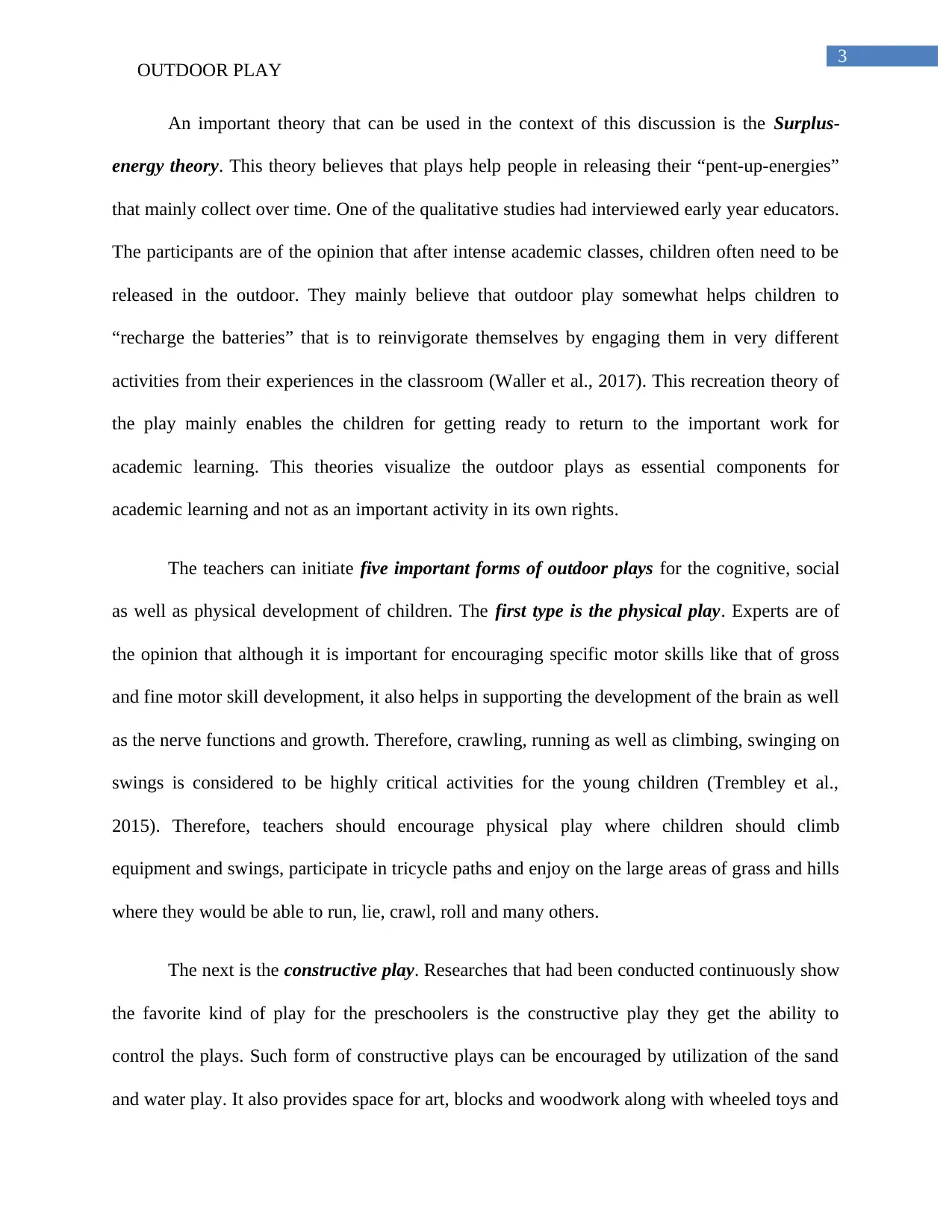
3
OUTDOOR PLAY
An important theory that can be used in the context of this discussion is the Surplus-
energy theory. This theory believes that plays help people in releasing their “pent-up-energies”
that mainly collect over time. One of the qualitative studies had interviewed early year educators.
The participants are of the opinion that after intense academic classes, children often need to be
released in the outdoor. They mainly believe that outdoor play somewhat helps children to
“recharge the batteries” that is to reinvigorate themselves by engaging them in very different
activities from their experiences in the classroom (Waller et al., 2017). This recreation theory of
the play mainly enables the children for getting ready to return to the important work for
academic learning. This theories visualize the outdoor plays as essential components for
academic learning and not as an important activity in its own rights.
The teachers can initiate five important forms of outdoor plays for the cognitive, social
as well as physical development of children. The first type is the physical play. Experts are of
the opinion that although it is important for encouraging specific motor skills like that of gross
and fine motor skill development, it also helps in supporting the development of the brain as well
as the nerve functions and growth. Therefore, crawling, running as well as climbing, swinging on
swings is considered to be highly critical activities for the young children (Trembley et al.,
2015). Therefore, teachers should encourage physical play where children should climb
equipment and swings, participate in tricycle paths and enjoy on the large areas of grass and hills
where they would be able to run, lie, crawl, roll and many others.
The next is the constructive play. Researches that had been conducted continuously show
the favorite kind of play for the preschoolers is the constructive play they get the ability to
control the plays. Such form of constructive plays can be encouraged by utilization of the sand
and water play. It also provides space for art, blocks and woodwork along with wheeled toys and
OUTDOOR PLAY
An important theory that can be used in the context of this discussion is the Surplus-
energy theory. This theory believes that plays help people in releasing their “pent-up-energies”
that mainly collect over time. One of the qualitative studies had interviewed early year educators.
The participants are of the opinion that after intense academic classes, children often need to be
released in the outdoor. They mainly believe that outdoor play somewhat helps children to
“recharge the batteries” that is to reinvigorate themselves by engaging them in very different
activities from their experiences in the classroom (Waller et al., 2017). This recreation theory of
the play mainly enables the children for getting ready to return to the important work for
academic learning. This theories visualize the outdoor plays as essential components for
academic learning and not as an important activity in its own rights.
The teachers can initiate five important forms of outdoor plays for the cognitive, social
as well as physical development of children. The first type is the physical play. Experts are of
the opinion that although it is important for encouraging specific motor skills like that of gross
and fine motor skill development, it also helps in supporting the development of the brain as well
as the nerve functions and growth. Therefore, crawling, running as well as climbing, swinging on
swings is considered to be highly critical activities for the young children (Trembley et al.,
2015). Therefore, teachers should encourage physical play where children should climb
equipment and swings, participate in tricycle paths and enjoy on the large areas of grass and hills
where they would be able to run, lie, crawl, roll and many others.
The next is the constructive play. Researches that had been conducted continuously show
the favorite kind of play for the preschoolers is the constructive play they get the ability to
control the plays. Such form of constructive plays can be encouraged by utilization of the sand
and water play. It also provides space for art, blocks and woodwork along with wheeled toys and
Paraphrase This Document
Need a fresh take? Get an instant paraphrase of this document with our AI Paraphraser
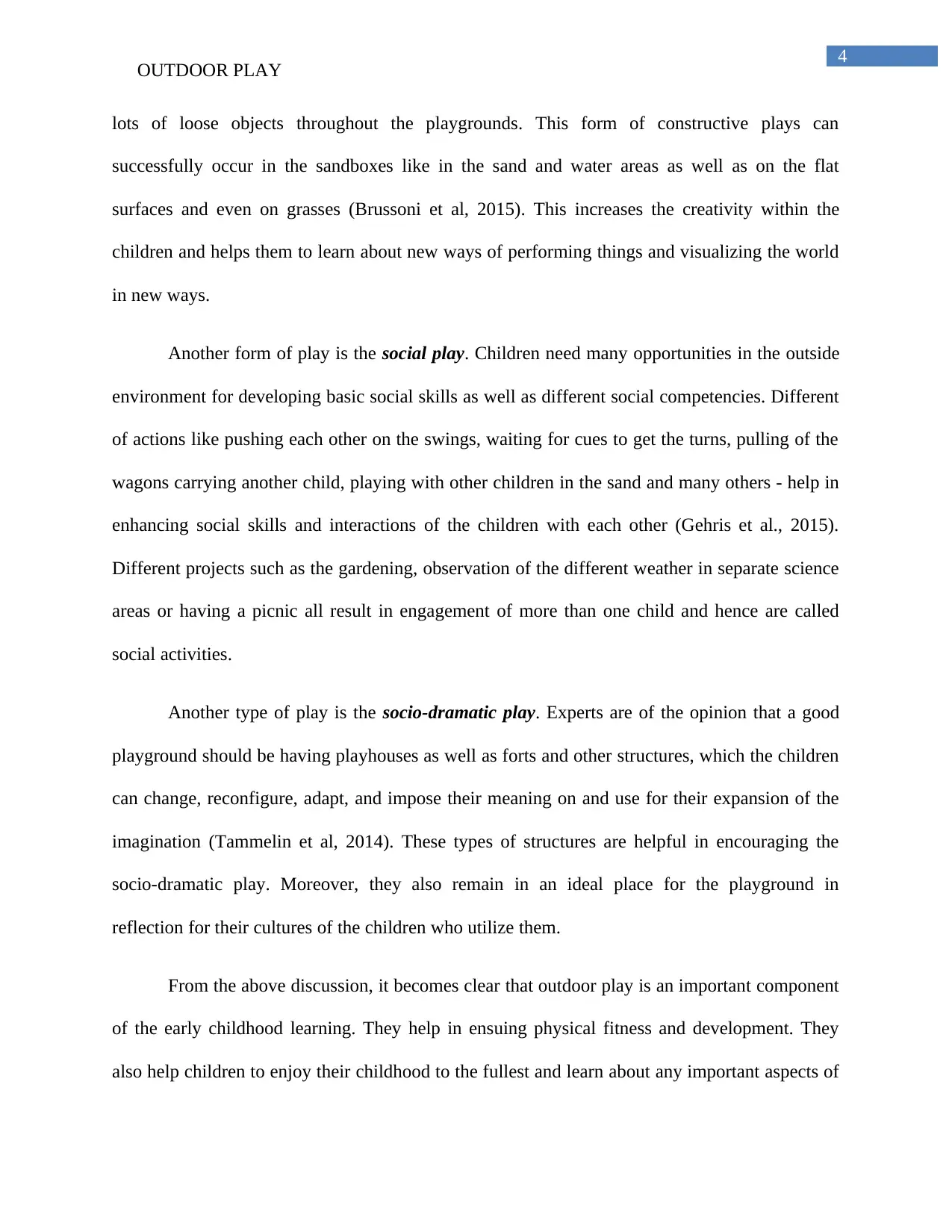
4
OUTDOOR PLAY
lots of loose objects throughout the playgrounds. This form of constructive plays can
successfully occur in the sandboxes like in the sand and water areas as well as on the flat
surfaces and even on grasses (Brussoni et al, 2015). This increases the creativity within the
children and helps them to learn about new ways of performing things and visualizing the world
in new ways.
Another form of play is the social play. Children need many opportunities in the outside
environment for developing basic social skills as well as different social competencies. Different
of actions like pushing each other on the swings, waiting for cues to get the turns, pulling of the
wagons carrying another child, playing with other children in the sand and many others - help in
enhancing social skills and interactions of the children with each other (Gehris et al., 2015).
Different projects such as the gardening, observation of the different weather in separate science
areas or having a picnic all result in engagement of more than one child and hence are called
social activities.
Another type of play is the socio-dramatic play. Experts are of the opinion that a good
playground should be having playhouses as well as forts and other structures, which the children
can change, reconfigure, adapt, and impose their meaning on and use for their expansion of the
imagination (Tammelin et al, 2014). These types of structures are helpful in encouraging the
socio-dramatic play. Moreover, they also remain in an ideal place for the playground in
reflection for their cultures of the children who utilize them.
From the above discussion, it becomes clear that outdoor play is an important component
of the early childhood learning. They help in ensuing physical fitness and development. They
also help children to enjoy their childhood to the fullest and learn about any important aspects of
OUTDOOR PLAY
lots of loose objects throughout the playgrounds. This form of constructive plays can
successfully occur in the sandboxes like in the sand and water areas as well as on the flat
surfaces and even on grasses (Brussoni et al, 2015). This increases the creativity within the
children and helps them to learn about new ways of performing things and visualizing the world
in new ways.
Another form of play is the social play. Children need many opportunities in the outside
environment for developing basic social skills as well as different social competencies. Different
of actions like pushing each other on the swings, waiting for cues to get the turns, pulling of the
wagons carrying another child, playing with other children in the sand and many others - help in
enhancing social skills and interactions of the children with each other (Gehris et al., 2015).
Different projects such as the gardening, observation of the different weather in separate science
areas or having a picnic all result in engagement of more than one child and hence are called
social activities.
Another type of play is the socio-dramatic play. Experts are of the opinion that a good
playground should be having playhouses as well as forts and other structures, which the children
can change, reconfigure, adapt, and impose their meaning on and use for their expansion of the
imagination (Tammelin et al, 2014). These types of structures are helpful in encouraging the
socio-dramatic play. Moreover, they also remain in an ideal place for the playground in
reflection for their cultures of the children who utilize them.
From the above discussion, it becomes clear that outdoor play is an important component
of the early childhood learning. They help in ensuing physical fitness and development. They
also help children to enjoy their childhood to the fullest and learn about any important aspects of
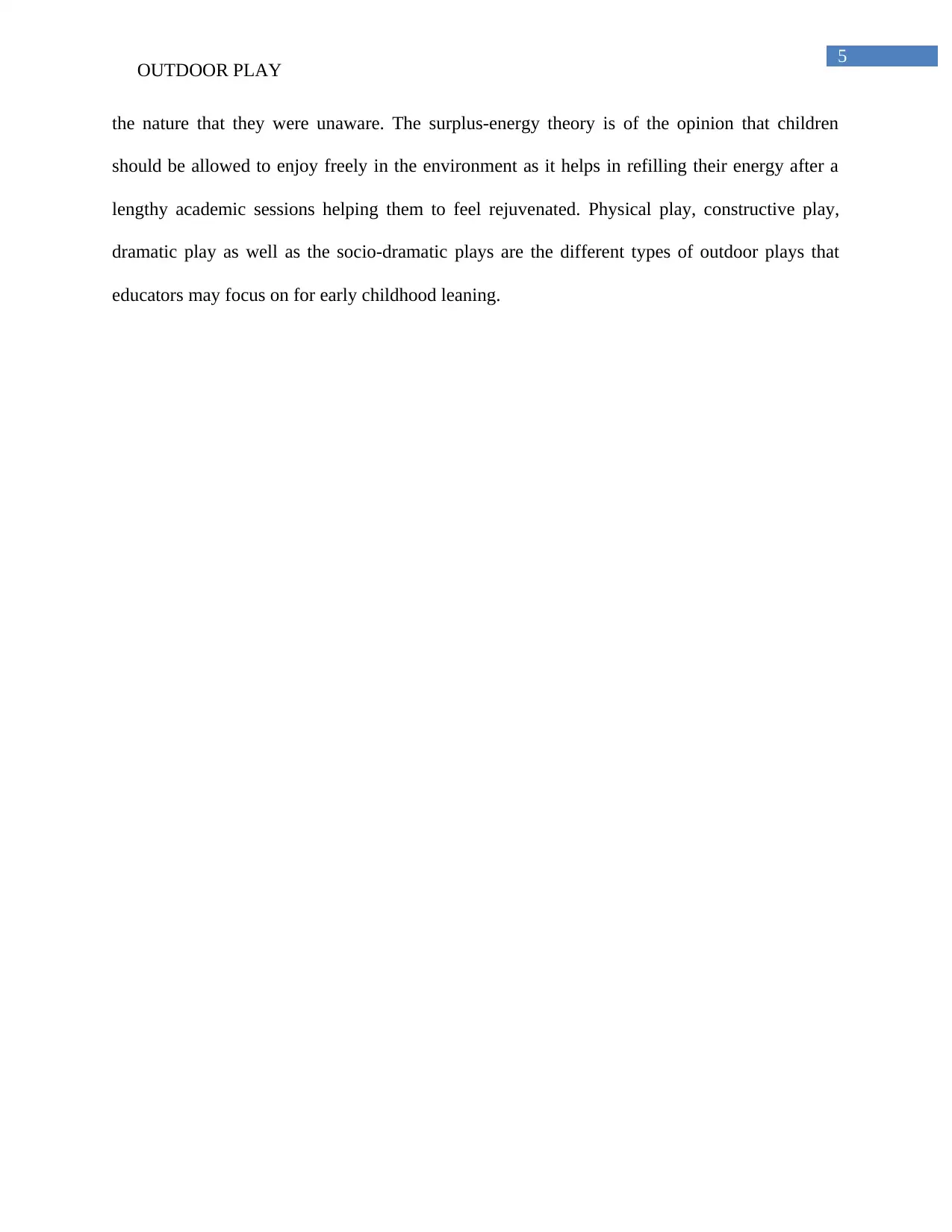
5
OUTDOOR PLAY
the nature that they were unaware. The surplus-energy theory is of the opinion that children
should be allowed to enjoy freely in the environment as it helps in refilling their energy after a
lengthy academic sessions helping them to feel rejuvenated. Physical play, constructive play,
dramatic play as well as the socio-dramatic plays are the different types of outdoor plays that
educators may focus on for early childhood leaning.
OUTDOOR PLAY
the nature that they were unaware. The surplus-energy theory is of the opinion that children
should be allowed to enjoy freely in the environment as it helps in refilling their energy after a
lengthy academic sessions helping them to feel rejuvenated. Physical play, constructive play,
dramatic play as well as the socio-dramatic plays are the different types of outdoor plays that
educators may focus on for early childhood leaning.
⊘ This is a preview!⊘
Do you want full access?
Subscribe today to unlock all pages.

Trusted by 1+ million students worldwide
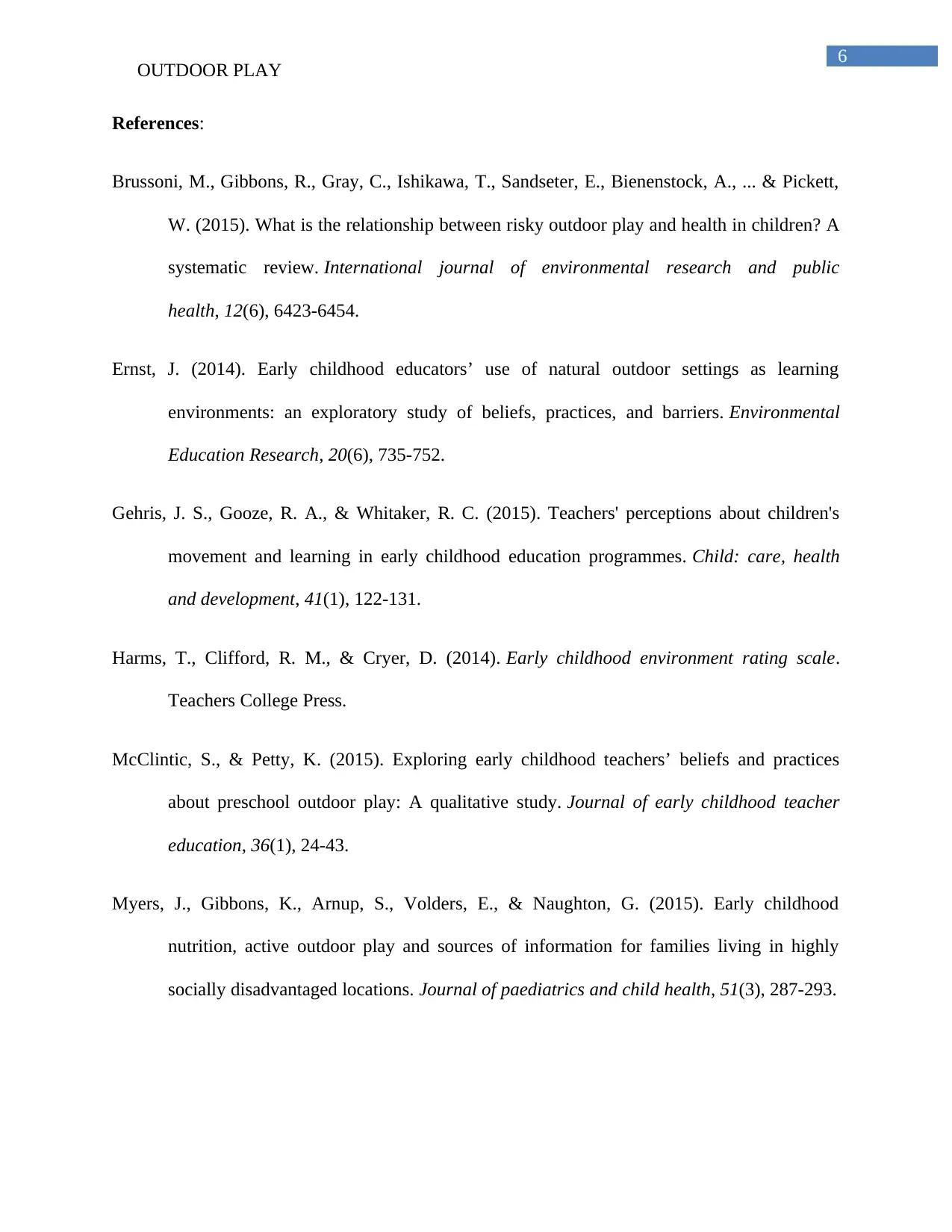
6
OUTDOOR PLAY
References:
Brussoni, M., Gibbons, R., Gray, C., Ishikawa, T., Sandseter, E., Bienenstock, A., ... & Pickett,
W. (2015). What is the relationship between risky outdoor play and health in children? A
systematic review. International journal of environmental research and public
health, 12(6), 6423-6454.
Ernst, J. (2014). Early childhood educators’ use of natural outdoor settings as learning
environments: an exploratory study of beliefs, practices, and barriers. Environmental
Education Research, 20(6), 735-752.
Gehris, J. S., Gooze, R. A., & Whitaker, R. C. (2015). Teachers' perceptions about children's
movement and learning in early childhood education programmes. Child: care, health
and development, 41(1), 122-131.
Harms, T., Clifford, R. M., & Cryer, D. (2014). Early childhood environment rating scale.
Teachers College Press.
McClintic, S., & Petty, K. (2015). Exploring early childhood teachers’ beliefs and practices
about preschool outdoor play: A qualitative study. Journal of early childhood teacher
education, 36(1), 24-43.
Myers, J., Gibbons, K., Arnup, S., Volders, E., & Naughton, G. (2015). Early childhood
nutrition, active outdoor play and sources of information for families living in highly
socially disadvantaged locations. Journal of paediatrics and child health, 51(3), 287-293.
OUTDOOR PLAY
References:
Brussoni, M., Gibbons, R., Gray, C., Ishikawa, T., Sandseter, E., Bienenstock, A., ... & Pickett,
W. (2015). What is the relationship between risky outdoor play and health in children? A
systematic review. International journal of environmental research and public
health, 12(6), 6423-6454.
Ernst, J. (2014). Early childhood educators’ use of natural outdoor settings as learning
environments: an exploratory study of beliefs, practices, and barriers. Environmental
Education Research, 20(6), 735-752.
Gehris, J. S., Gooze, R. A., & Whitaker, R. C. (2015). Teachers' perceptions about children's
movement and learning in early childhood education programmes. Child: care, health
and development, 41(1), 122-131.
Harms, T., Clifford, R. M., & Cryer, D. (2014). Early childhood environment rating scale.
Teachers College Press.
McClintic, S., & Petty, K. (2015). Exploring early childhood teachers’ beliefs and practices
about preschool outdoor play: A qualitative study. Journal of early childhood teacher
education, 36(1), 24-43.
Myers, J., Gibbons, K., Arnup, S., Volders, E., & Naughton, G. (2015). Early childhood
nutrition, active outdoor play and sources of information for families living in highly
socially disadvantaged locations. Journal of paediatrics and child health, 51(3), 287-293.
Paraphrase This Document
Need a fresh take? Get an instant paraphrase of this document with our AI Paraphraser
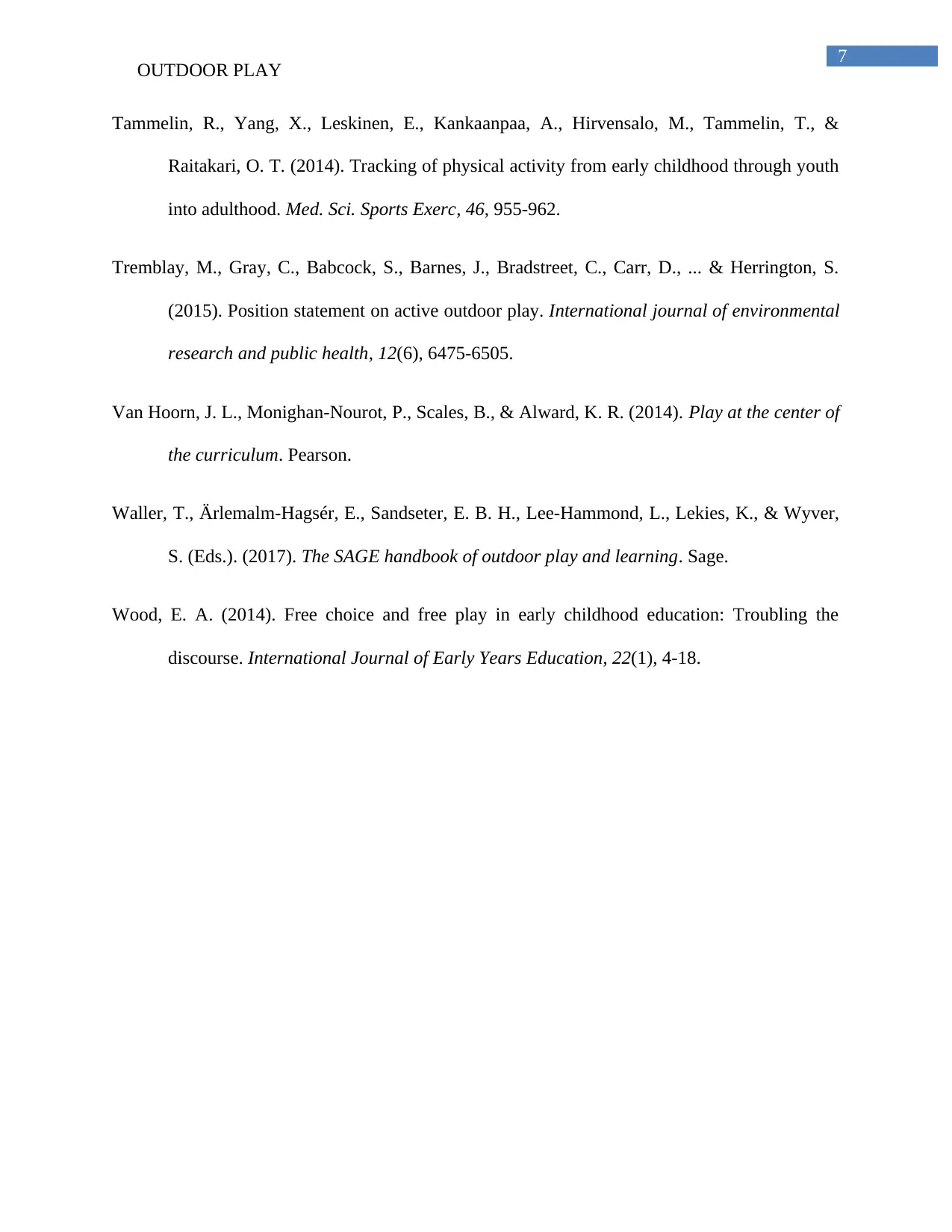
7
OUTDOOR PLAY
Tammelin, R., Yang, X., Leskinen, E., Kankaanpaa, A., Hirvensalo, M., Tammelin, T., &
Raitakari, O. T. (2014). Tracking of physical activity from early childhood through youth
into adulthood. Med. Sci. Sports Exerc, 46, 955-962.
Tremblay, M., Gray, C., Babcock, S., Barnes, J., Bradstreet, C., Carr, D., ... & Herrington, S.
(2015). Position statement on active outdoor play. International journal of environmental
research and public health, 12(6), 6475-6505.
Van Hoorn, J. L., Monighan-Nourot, P., Scales, B., & Alward, K. R. (2014). Play at the center of
the curriculum. Pearson.
Waller, T., Ärlemalm-Hagsér, E., Sandseter, E. B. H., Lee-Hammond, L., Lekies, K., & Wyver,
S. (Eds.). (2017). The SAGE handbook of outdoor play and learning. Sage.
Wood, E. A. (2014). Free choice and free play in early childhood education: Troubling the
discourse. International Journal of Early Years Education, 22(1), 4-18.
OUTDOOR PLAY
Tammelin, R., Yang, X., Leskinen, E., Kankaanpaa, A., Hirvensalo, M., Tammelin, T., &
Raitakari, O. T. (2014). Tracking of physical activity from early childhood through youth
into adulthood. Med. Sci. Sports Exerc, 46, 955-962.
Tremblay, M., Gray, C., Babcock, S., Barnes, J., Bradstreet, C., Carr, D., ... & Herrington, S.
(2015). Position statement on active outdoor play. International journal of environmental
research and public health, 12(6), 6475-6505.
Van Hoorn, J. L., Monighan-Nourot, P., Scales, B., & Alward, K. R. (2014). Play at the center of
the curriculum. Pearson.
Waller, T., Ärlemalm-Hagsér, E., Sandseter, E. B. H., Lee-Hammond, L., Lekies, K., & Wyver,
S. (Eds.). (2017). The SAGE handbook of outdoor play and learning. Sage.
Wood, E. A. (2014). Free choice and free play in early childhood education: Troubling the
discourse. International Journal of Early Years Education, 22(1), 4-18.
1 out of 8
Related Documents
Your All-in-One AI-Powered Toolkit for Academic Success.
+13062052269
info@desklib.com
Available 24*7 on WhatsApp / Email
![[object Object]](/_next/static/media/star-bottom.7253800d.svg)
Unlock your academic potential
Copyright © 2020–2025 A2Z Services. All Rights Reserved. Developed and managed by ZUCOL.





